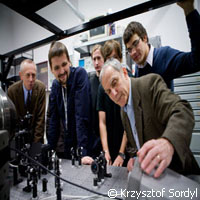Strontium at the heart of time
On 17 February 2011, an EU-funded team of physicists in Poland announced the completion of a crucial step towards the assembly of one of the world's most precise clocks. The last of three key components for this clock, an atomic frequency standard based on cold strontium atoms, has just been set in motion. The scientists expect to assemble the clock before the end of the year. The Polish optical atomic clock construction project was launched two years ago in the wider framework of the National Laboratory for Atomic, Molecular and Optical Physics (KL FAMO), which is a part of the Polish National Laboratory for Quantum Technologies (NLTK). The NLTK is a consortium of leading Polish scientific organisations conducting research in the field of quantum technologies. While the clock construction project is funded by the Polish Ministry of Science and Higher Education, the European Regional Development Fund contributes to the funding of the NLTK Project as part of the Operational Programme 'Innovative Economy 2007-2013'. Groups of scientists throughout the country are involved in this ambitious collaborative effort. The device they are developing is expected to exceed the performance of the most advanced caesium clocks currently in use by as much as two orders of magnitude. Clocks are based on periodic physical phenomena which provide a frequency standard - a quartz resonator with an oscillating quartz crystal, for example, in the case of a wristwatch. 'Commonly used atomic clocks make use of an electronic transition between energy levels in caesium atoms,' the team notes, explaining that the Polish project has opted for a different approach. 'The physicists from Cracow ... have constructed a standard based on strontium atoms, in which electronic transitions between atomic energy levels require absorption and emission of electromagnetic radiation of a much higher frequency than in caesium. The frequency lies in the optical range (hence the adjective "optical" in the name of the clock).' A higher frequency translates into smaller measurement units, and so into a higher degree of precision. Ultra-precise clocks are used, among other things, to define the standard second, a value that is central to all timekeeping applications. Many of the systems on which society has come to rely, such as modern telecommunications and navigation systems, require a high degree of precision. But there are other applications. For example, the ability to measure time very accurately indeed also underpins a range of research into the fundamental properties of reality. 'The Polish clock will have an accuracy of one second in a few dozen billion years, which is a period several times longer than that which elapsed from the Big Bang. Such precise timekeeping devices can nowadays be found only in a handful of research centres in the world,' says Professor Wojciech Gawlik at the Department of Photonics of the Institute of Physics at the Jagiellonian University in Cracow. Professor Gawlik leads the team of scientists who built the atomic frequency standard. The standard will eventually be delivered to KL FAMO in Torun, where the clock will be assembled. The two other key components of the clock are an optical comb and an ultra-precise laser, respectively developed by teams headed up by scientists from the University of Warsaw and the Nicolaus Copernicus University. Commenting on their latest achievement, the researchers explain that the role of the atomic standard is to stabilise the frequency of the laser. 'The vibrations of the electric field of a light beam emitted by the laser ... will be counted as elementary units of time, recurring with great precision.' However, the frequency is so high that electronic systems would not be able to keep track of the oscillations. This is achieved, instead, with the help of a frequency comb, 'a set of numerous light waves of narrow, equidistant frequencies. The comb, generated by a laser emitting ultra-short light pulses, allows for a synchronic and error-free transfer of atomic standard oscillations into radio wave frequency range - radio waves can be electronically counted.' 'Our atomic standard based on strontium atoms is the third, final piece of the puzzle. In several months' time, after the tests and after transporting it to Torun, we will be able to start putting the clock together,' observes Professor Gawlik. The completion of the clock will mark a new milestone for the children of Copernicus - in the city of his birth.For more information, please visit:National Laboratory for Quantum Technologies, Poland (in Polish):http://nltk.fuw.edu.plDepartment of Photonics, Jagiellonian University:http://www.if.uj.edu.pl/pl/ZF/index.php?name=main&l=enNational Laboratory for Atomic, Molecular and Optical Physics (KL FAMO), Poland:http://www.fizyka.umk.pl/famo_en/Ultrafast Phenomena Lab, University of Warsaw:http://ultrafast.fuw.edu.plEuropean Regional Development Fund (ERDF):http://ec.europa.eu/regional_policy/funds/feder/index_en.htm
Countries
Poland



